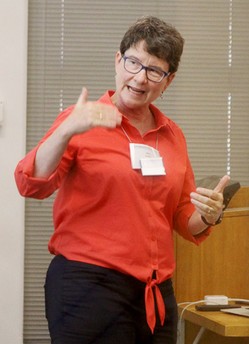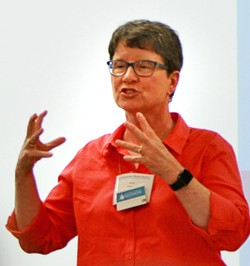For much of her adult life as a pastor and associate presbyter, Ann Philbrick, associate for church growth and transformation for Presbyterian Mission Agency, has been interested in one key question: “What happens to congregations, that they get so stuck?”
After more than 25 years of congregation redevelopment work she had a basic truth to share during a workshop presentation at Big Tent 2015.
“Things change,” says Philbrick, as she shows the audience a picture of her parents on their wedding day in 1955, followed by a picture of them in their 70’s. “They’re no longer here, we can’t avoid it—we’re all going to die.”
Acknowledging the biological cycle of life for a person is helpful, Philbrick says, in understanding organizational life cycles, and how the changes that happen to us as individuals affect our communal church experience.
“The information we’re learning about life cycles in congregations can feel demoralizing,” she says. “The assumption is life can be extended beyond what I’m about to tell you, if a church is able to find new vision—that connects the congregation back to the larger community.”
Without this kind of intervention, the normal organization life cycle of a congregation moves from its starting date into three distinct periods: incline, recline and decline. She says the path to avoiding death is a new vision that reconnects the church to its purpose for starting.
The incline period typically lasts about 25-30 years. During this time the church is living into a vision for the future, which hasn’t been accomplished yet. It is very outward focused on a community of people who aren’t part of the church yet. On the incline, churches take greater risk and make decisions based on whether it will help them achieve their vision.
“During the incline, ministry capacity is expanding,” says Philbrick. “An early intervention in this life cycle would be to focus on the spiritual development and growth of those coming, rather than making the success just about the numbers.”
Philbrick tells pastors “all the time” to stop worrying about those aren’t coming.
“I think we’d all be amazed at what we could do,” she says, “if we developed deep spiritual growth in our people,” helping them see God’s ministry and mission at work in their lives and the community around them.
At some point in the incline cycle a historical drift starts to happen in organizations as the move away from the original vision—the reason they started. This is where churches enter into a period of recline that lasts for about 50-years. Living into the present, the church is very focused on members of the congregations. They begin to take less risk, making decisions based on whether they can afford it. Strategic planning becomes a task of maintaining the programs they did this year, and plugging them into the next church calendar year.

Ann Philbrick, associate for church growth and transformation —Jennie Littleton for Presbyterian News Service
“Churches have more energy, money and power in the recline phase to create change, but too often they dig in saying ‘why should we do anything different?’” says Philbrick. “You can still be growing in a recline time,” says Philbrick. “But what churches start to notice is they have more members, but worship attendance is stagnant, maybe even beginning to decline.”
Eventually the organizational life cycle moves into decline. This is where churches focus on the past. They begin to get stuck, unable to risk anything because of fear.
In this phase, while the motivation to change is great, it is also harder. The vision, strategy and programs disappear in this phase, leaving the church with its structure—the building.
“This is why it’s important to pay attention where your church is in this organizational life cycle—so you know the long term work you need to do, and when to do it,” she says. “I always tell people it’s a one-way street, you don’t get to go back.”
Philbrick believes all of the missional conversations happening in the Presbyterian Church, (U.S.A.) will help churches find language and vision “to reclaim their incline ways of being.”
“We’ve tended to shoot for recline, to achieve the vision and then settle in and stay there forever,” she says. “But this idea—that we are being sent again into our neighborhoods and communities to participate in God’s mission in our world—may help us discover ways to be the future again.”
-----
Editors Note: Philbrick’s primary work in the Mission Agency is with New Beginnings, a discernment process that helps churches make meaningful decisions about their future. She recommends the kindle e-book by George Bullard, “10 Congregational Issues for Generative Dialogue,” to help churches talk about and evaluate where they in their organizational life cycle.

